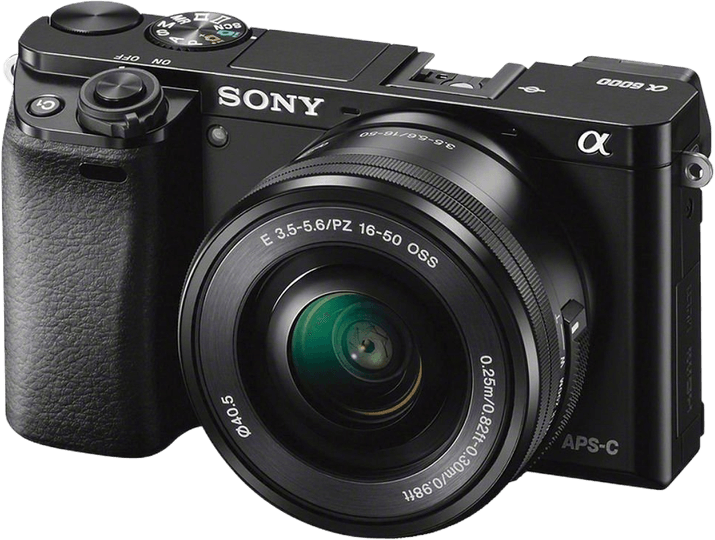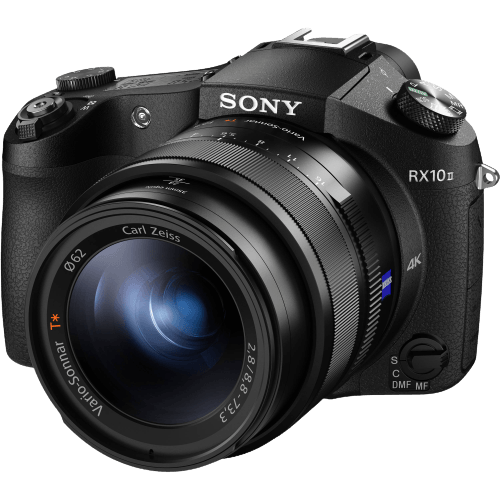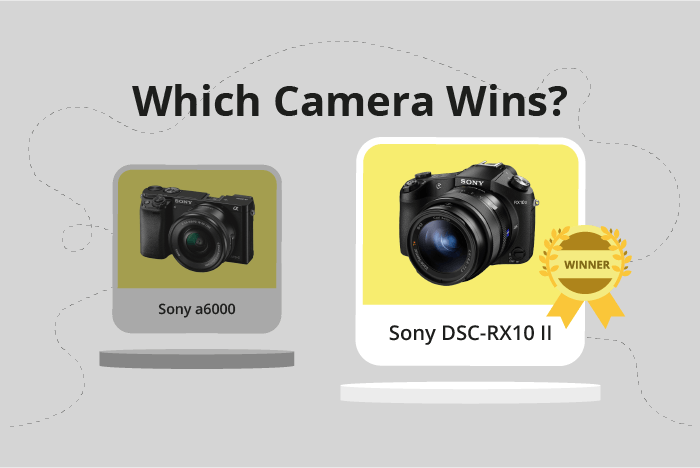Sony a6000 vs Cyber-shot DSC-RX10 II Comparison
Sony a6000

Sony Cyber-shot DSC-RX10 II

The Sony Cyber-shot DSC-RX10 II narrowly wins with a score of 59/100, while the Sony a6000 follows closely with 57/100. Both cameras were released in the mid-2010s, with the Sony a6000 launching in 2014 and the Sony Cyber-shot DSC-RX10 II in 2015. They share common features such as their launch prices of $799 and $1299, respectively.
The Sony a6000, a mirrorless camera, has the advantage of being lighter at 344g (0.76lbs) and smaller with dimensions of 120 x 67 x 45mm. This makes it more portable and easier to carry around. On the other hand, the Sony Cyber-shot DSC-RX10 II, a bridge camera, offers a higher score due to its superior performance and features. However, it is heavier at 813g (1.79lbs) and larger with dimensions of 129 x 88 x 102mm.
Taking these factors into account, the Sony Cyber-shot DSC-RX10 II is the better choice for those seeking top-notch performance, while the Sony a6000 is ideal for those who prioritize portability and ease of use.
Sony a6000 vs Cyber-shot DSC-RX10 II Overview and Optics
The Sony a6000 outperforms the Sony Cyber-shot DSC-RX10 II in optics, scoring 67/100 compared to the latter’s 64/100. Both cameras share similarities, including a CMOS sensor type, Bionz X processor, and no lens mount for the DSC-RX10 II due to its fixed lens. Despite these common features, the a6000 comes out ahead in certain aspects.
The a6000 boasts a higher megapixel count at 24.3, compared to the DSC-RX10 II’s 20 megapixels. This difference allows the a6000 to capture more detail and produce higher resolution images. Furthermore, the a6000’s sensor size is APS-C, while the DSC-RX10 II has a smaller 1″ sensor. The larger sensor size contributes to better image quality and low-light performance. The a6000 also has a higher DXOMARK score for its sensor at 82, indicating superior overall sensor performance.
On the other hand, the DSC-RX10 II has some advantages over the a6000. Its shooting speed is faster at 14 frames per second, compared to the a6000’s 11 frames per second. This makes the DSC-RX10 II more suitable for capturing fast-moving subjects. Additionally, the DSC-RX10 II has image stabilization, which the a6000 lacks. This feature helps reduce camera shake and produce sharper images, especially in low-light situations.
Taking these factors into consideration, the Sony a6000’s higher megapixel count, larger sensor size, and superior DXOMARK score make it the better choice for those seeking optimal image quality. However, the Sony Cyber-shot DSC-RX10 II’s faster shooting speed and image stabilization may be more appealing to photographers who prioritize capturing action shots or shooting in low-light conditions.
Sony a6000 vs Cyber-shot DSC-RX10 II Video Performance
The Sony Cyber-shot DSC-RX10 II outperforms the Sony a6000 in video capabilities with a score of 77 out of 100, compared to the a6000’s score of 56. Both cameras share some common specifications, such as lacking built-in time-lapse functionality. However, there are significant differences that set the two cameras apart.
The DSC-RX10 II excels with its 4K video resolution and maximum video dimensions of 3840 x 2160, providing much higher quality video capture than the a6000, which only reaches Full HD resolution and 1920 x 1080 video dimensions. Additionally, the DSC-RX10 II offers a superior maximum video frame rate of 120fps, allowing for smooth slow-motion video capture. In contrast, the a6000 has a maximum frame rate of just 60fps.
While the a6000 does not surpass the DSC-RX10 II in any specific video capabilities, it is still a capable camera with Full HD video resolution and a respectable maximum video frame rate of 60fps. For casual users or those not requiring the highest video quality, the a6000 may still be a suitable choice.
Taking all factors into account, the Sony Cyber-shot DSC-RX10 II is the clear winner in terms of video capabilities, with its superior video resolution, dimensions, and frame rate. The Sony a6000, while not as strong in this area, still remains a viable option for those with less demanding video requirements.
Sony a6000 vs Cyber-shot DSC-RX10 II Features and Benefits
The Sony Cyber-shot DSC-RX10 II emerges as the winner in the features comparison with a score of 57/100, while the Sony a6000 trails behind with a score of 41/100. Both cameras share several specifications, including a 3-inch screen size, the absence of a touchscreen, and the lack of GPS functionality. Additionally, both cameras are equipped with Wi-Fi capabilities, allowing for easy sharing and transfer of images.
The winning camera, the Sony Cyber-shot DSC-RX10 II, boasts a higher screen resolution of 1,228,800 dots, providing a sharper and more detailed display. Moreover, this camera features Bluetooth connectivity, which enhances its wireless capabilities and offers seamless pairing with compatible devices.
On the other hand, the Sony a6000 has its advantages as well. This camera includes a flip screen, which allows users to capture images and videos from various angles with ease. This feature is particularly useful for vloggers and content creators who require flexibility in their shots.
Taking these factors into account, it is evident that the Sony Cyber-shot DSC-RX10 II offers a superior feature set, primarily due to its higher screen resolution and the addition of Bluetooth connectivity. However, the Sony a6000’s flip screen functionality may appeal to users who prioritize versatility in their shooting angles. Ultimately, the choice between these two cameras depends on the individual’s specific needs and preferences.
Sony a6000 vs Cyber-shot DSC-RX10 II Storage and Battery
The Sony Cyber-shot DSC-RX10 II outperforms the Sony a6000 in storage and battery, scoring 24/100 compared to the a6000’s 21/100. Both cameras share similarities in this category, with each having one memory card slot and accepting the same types of memory cards: SD/SDHC/SDXC, Memory Stick Pro Duo/Pro-HG Duo for the a6000, and Memory Stick Duo/Pro Duo/Pro-HG Duo for the RX10 II. Additionally, both cameras use the same NP-FW50 battery type and lack USB charging.
The RX10 II has a slight advantage in battery life, offering 400 shots per charge compared to the a6000’s 360 shots. This allows for more extended periods of shooting without needing to replace or recharge the battery. On the other hand, the a6000 does not have any clear advantages in storage and battery over the RX10 II.
Considering these factors, the RX10 II is the better choice for users prioritizing storage and battery capabilities, while the a6000 does not offer any significant benefits in this area.
Sony a6000 vs Cyber-shot DSC-RX10 II – Our Verdict
Are you still undecided about which camera is right for you? Have a look at these popular comparisons that feature the Sony a6000 or the Sony Cyber-shot DSC-RX10 II:

